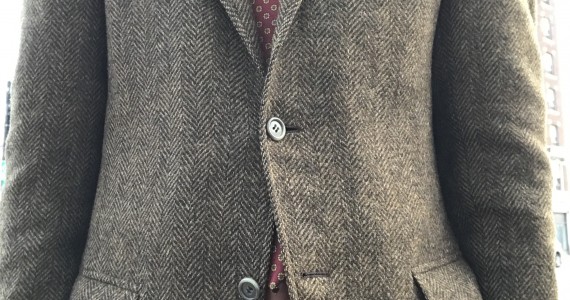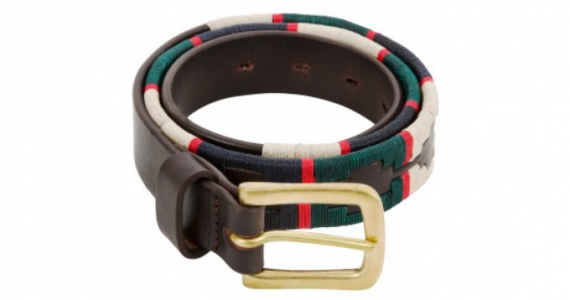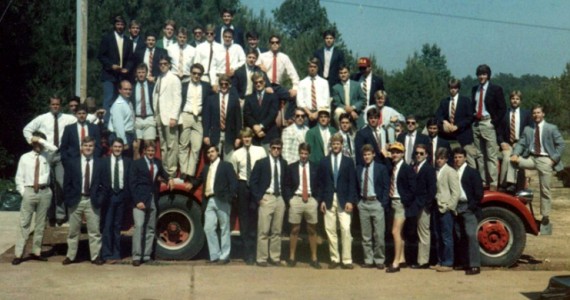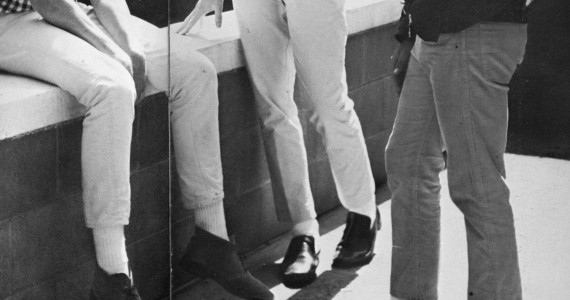Last week I broke out a tweed that I don’t think that I have posted before. It is probably the most ivy looking jacket that I own. It is also not as ivy you might think.
 I rarely thrift or buy second-hand clothes these days. It is not because I am too good for it and have all my clothes MTM, but rather it almost never works out for me. I am currently batting about 10%. This jacket however i purchased on a second-had site and (drum roll!) it worked out. The jacket is Varsity Town’s Madisionaire. If this name rings a bell it is probably because Christian at Ivy Style wrote an article about it (Varsity Town’s Madisonaire, 1966).
I rarely thrift or buy second-hand clothes these days. It is not because I am too good for it and have all my clothes MTM, but rather it almost never works out for me. I am currently batting about 10%. This jacket however i purchased on a second-had site and (drum roll!) it worked out. The jacket is Varsity Town’s Madisionaire. If this name rings a bell it is probably because Christian at Ivy Style wrote an article about it (Varsity Town’s Madisonaire, 1966).

The Madisonaire is a perfect example of heyday Ivy. It has a 3/2 roll, natural shoulders, narrow lapels, swelled edges, and a hook vent. The lapel rolls the way they do in the old movies. It just looks ivy, and while it looks ivy it wasn’t made for the Brooks Brothers or J.Press crowd, but instead was intended for mainstream America. To quote the Ivy Style article, “Either way it’s still Main Street, a wonderful example of commerce at work and the flourishing of the Ivy League Look to men across the nation, who, if they couldn’t get the real deal, could at least get a replica.”
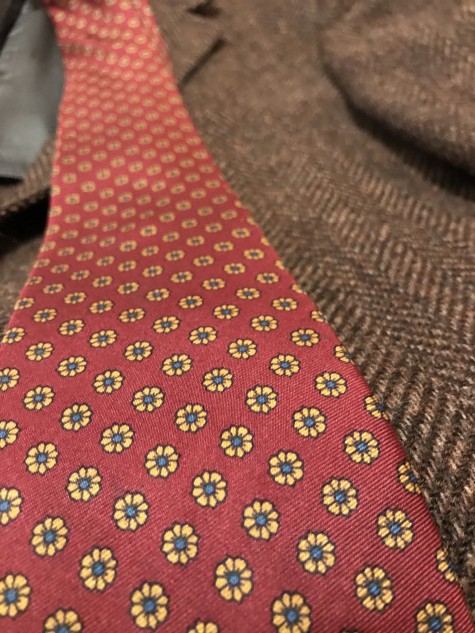
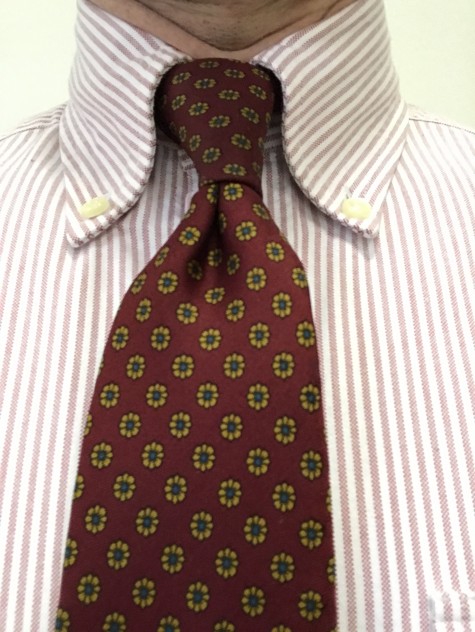 A few things to take away from this post. One, is that authenticity is tricky. Is this item ivy league or is it a cheap replica? Two, even though your vintage item may have been mid-market in its day its quality may be closer to today’s high-end tailored clothing. Three, repp ties are great, but don’t forget about foulards. They are perfect for tweed.
A few things to take away from this post. One, is that authenticity is tricky. Is this item ivy league or is it a cheap replica? Two, even though your vintage item may have been mid-market in its day its quality may be closer to today’s high-end tailored clothing. Three, repp ties are great, but don’t forget about foulards. They are perfect for tweed.
All posts in Clothing and History
Madison Avenue Does Main Street Ivy
What are Polo Belts?
I want to get a leather belt that is thinner than 1.25″. The reason why is that I have grown very accustomed to the thinner front of surcingle belts. I don’t want it to be a dress belt as I plan on wearing it with my 5-pocket cords. This search led me to Sid Mashburn. While looking at their selection of 1″ leather belts I noticed a belt (pictured above) that they referred to as a “polo” belt. I had never heard the term and thought nothing of until I saw a post on polo belts on Red Clay Soul.
I’ve been digging on the polo belts lately. I love the idea, as well as the culture from which the polo belts originate. Born in Argentina, they are typically leather belts with color-specific designs woven in to represent a team or a location. While they’ve been around forever, they were made popular, maybe even mainstream, by royalty:
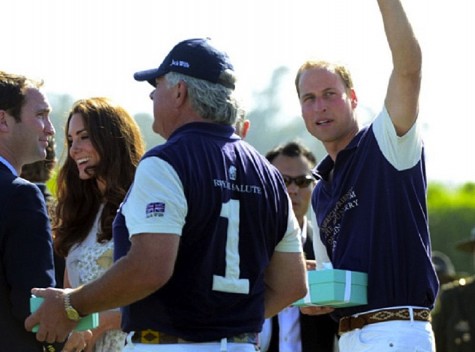
Head over to Red Clay Soul for more examples of the polo belt, where to find them, and a few ideas on how to wear them. Read the full post here: Polo Belts by Red Clay Soul
The Past & The Future of the L.L. Bean Anorak
The anorak made its way into the Trad cannon via Ivy Style as documented in the famed book Take Ivy. It was one of the lucky items to transcend the Ivy era and found itself perhaps even more popular among the 70’s prep crowd (The Late 70s Prep Look) . The anorak continues to weave in and out of mainstream popularity, but it has found a home for itself in the world of traditional American clothing. That about sums what I know about the anorak, but luckily for us we have a guest poster Kel Rhoads who knows his stuff and is going to give us a history lesson on the L.L. Bean Anorak (and a sneak peak at their 2017 anorak).
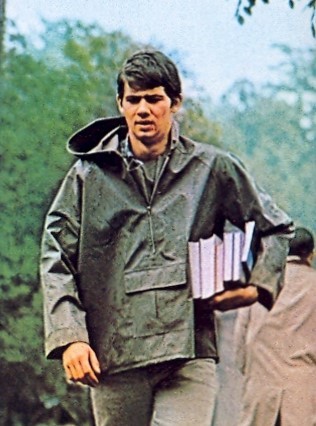 LL Bean, established purveyor of traditional clothing, has offered an anorak for over 70 years—although not continuously. For the past several years, if you wanted a traditional Bean anorak, you had to scour the used market. Fortunately, that’s about to change. A new Bean anorak will be released in early 2017. Given our interest in the garment, an LL Bean employee sent us an exclusive photograph of the upcoming model. We’ll show it to you in a bit, but first, let’s put the new anorak in its historical context.
LL Bean, established purveyor of traditional clothing, has offered an anorak for over 70 years—although not continuously. For the past several years, if you wanted a traditional Bean anorak, you had to scour the used market. Fortunately, that’s about to change. A new Bean anorak will be released in early 2017. Given our interest in the garment, an LL Bean employee sent us an exclusive photograph of the upcoming model. We’ll show it to you in a bit, but first, let’s put the new anorak in its historical context.
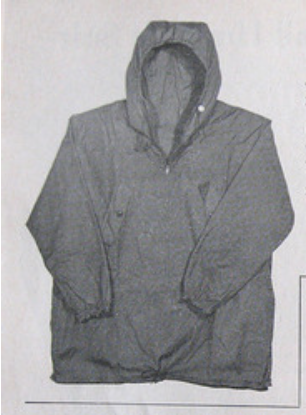
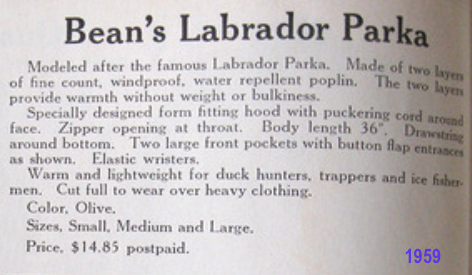 The second generation ushered in “Bean’s Anorak,” which had the familiar modern windbreaker look we recognize today. We suspect the second generation was offered throughout the 1970s and 1980s. They were made of slick, lightweight (2.5 oz./yard) nylon and had parallel seams on the chest. The elastic wrist bands on most of these vintage ‘raks have relaxed and need replacement, but otherwise they are still durable, functional garments—and still the lightest and most packable of any Bean anorak.
The second generation ushered in “Bean’s Anorak,” which had the familiar modern windbreaker look we recognize today. We suspect the second generation was offered throughout the 1970s and 1980s. They were made of slick, lightweight (2.5 oz./yard) nylon and had parallel seams on the chest. The elastic wrist bands on most of these vintage ‘raks have relaxed and need replacement, but otherwise they are still durable, functional garments—and still the lightest and most packable of any Bean anorak.
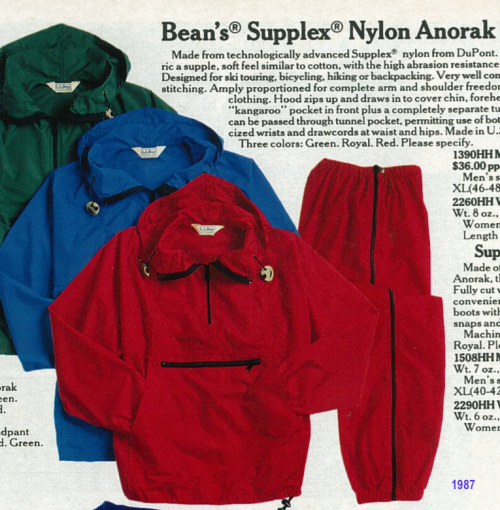 Popular demand caught up with Bean in 2012, when they reintroduced a fourth variant for just two years. They again called it the “Mountain Classic Anorak,” made of an even softer Supplex than previously. In many ways, however, the 2012 reissued Mountain Classic was more like the second-generation Bean’s Anorak with straight chest seams and vintage leather cord keepers at the hood. Bean also cut the fourth generation model considerably larger in the trunk, yielding a less athletic but comfortably drapey (some say tent-like) shape.
Popular demand caught up with Bean in 2012, when they reintroduced a fourth variant for just two years. They again called it the “Mountain Classic Anorak,” made of an even softer Supplex than previously. In many ways, however, the 2012 reissued Mountain Classic was more like the second-generation Bean’s Anorak with straight chest seams and vintage leather cord keepers at the hood. Bean also cut the fourth generation model considerably larger in the trunk, yielding a less athletic but comfortably drapey (some say tent-like) shape.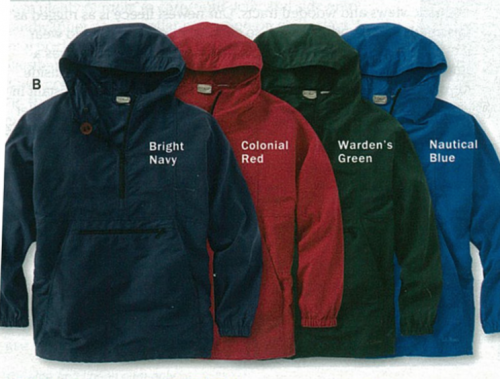
That brings us to the just-introduced fifth generation Bean anorak, called the “Mountain Classic Color Block Anorak” — although we’ve been assured one color scheme will be a sober black-on-black. Studying the photograph, it appears the anorak has gone back to a slimmer cut, possibly longer, and with a longer chest zipper. Its color-block style harkens back to the “Alpine” and “Aztec” designs of the 1990s, but less rambunctiously so. Bean has also revived their “Sunrise over Katahdin” label (which appeared in 1987) and placed it prominently on the chest. We have no idea how long Bean will offer the new 5th-gen, but we’re told they’ll debut in the Spring of 2017.
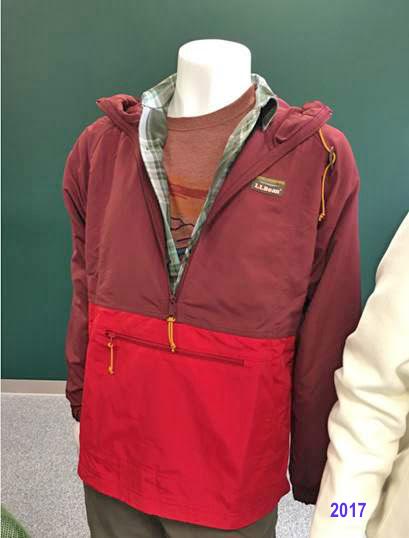 Modern windbreaker-style anoraks are favorites of travelers. There’s a cost of having to wriggle into a pullover that gives half the ventilation of a zip-up jacket. But the benefits are many: a streamlined front that doesn’t snag on pack straps, superior weather resistance, a long and lightweight barrier that wards off the grime of public transportation. And then there’s that magnificent kangaroo pocket. For the urban traveler, its great advantage is rapid deployment and concealment of valuables. While others are fumbling with wallets, packs and purses, the anorak’d traveler faces the vending machine, unzips, pays, and stashes change and receipt back into the pocket in seconds. By the time he or she turns away, everything’s zipped and secure, to be sorted out later. Pick-pockets hate anoraks!
Modern windbreaker-style anoraks are favorites of travelers. There’s a cost of having to wriggle into a pullover that gives half the ventilation of a zip-up jacket. But the benefits are many: a streamlined front that doesn’t snag on pack straps, superior weather resistance, a long and lightweight barrier that wards off the grime of public transportation. And then there’s that magnificent kangaroo pocket. For the urban traveler, its great advantage is rapid deployment and concealment of valuables. While others are fumbling with wallets, packs and purses, the anorak’d traveler faces the vending machine, unzips, pays, and stashes change and receipt back into the pocket in seconds. By the time he or she turns away, everything’s zipped and secure, to be sorted out later. Pick-pockets hate anoraks!Linking the Past to Present: 90’s Fraternity Style
The style known as Trad owes a lot to the Ivy League style for its heritage. However, this traditional American style was shaped by not only heyday Ivyist, but by each generation after that was interested in the traditional American look.
Just this week I read an interesting post that covered late 90’s fraternity style. This post featured Wallabee Clarks and polo shirts. Two items that were also included in the, “Definitive Late 70s Prep Checklist” post. This post on the 90’s in conjunction with the late 70’s Prep post helps to illustrate the path from Ivy style to Preppy to Trad.
I encourage you to head over to Red Clay Soul to read the article: LATE 90’S – EARLY 00’S FRATERNITY STYLE
Summer Wheat: The Denim Post
Rarely do you read about jeans on Trad & Ivy forums or blogs. It is a taboo topic. Just to provide a little context around the complex relationship between Trad and jeans, Christian from Ivy Style’s denim post was called “The End is Here: An Ivy Style Jeans Post.” Wheat jeans on the other hand have managed to escape the stigma of their blue brothers and have gained acceptance into the the world of Trad & Ivy.
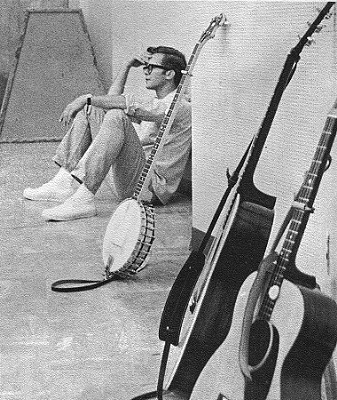
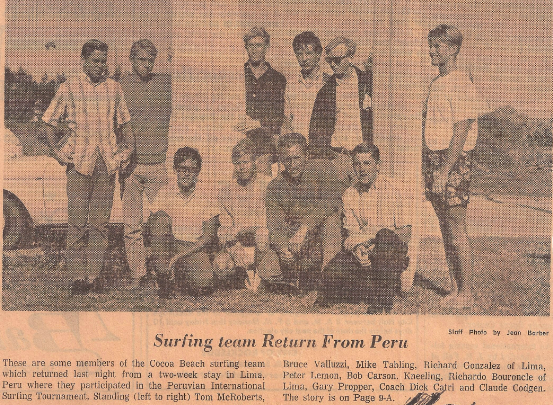 Wheat jeans get their credibility primarily from being a part of the 1960’s west coast prep look. From what I can put together wheat jeans gained popularity sometime in the early 60’s as part of the west coast prep/Beach Boy/surfer look. Wheat jeans were worn right along with Pendletons, Purcells, and all of the other west coast classics that have worked their way into Ivy League closets
Wheat jeans get their credibility primarily from being a part of the 1960’s west coast prep look. From what I can put together wheat jeans gained popularity sometime in the early 60’s as part of the west coast prep/Beach Boy/surfer look. Wheat jeans were worn right along with Pendletons, Purcells, and all of the other west coast classics that have worked their way into Ivy League closets
There are currently two great threads about wheat denim that touch on their history and where you can find a pair now. AAAT member Gamma68, started the “The Trad Wheat Jeans Thread.” One of the gems of this thread is member Reuben’s suggestion of getting a pair of wheat jeans from Wrangler. He recommends the Wrangler Cowboy Cut in tan (See here) and others seem to agree. Another great read is Talk Ivy’s, “Surf Ivy/The West Coast Look,” started by Member Tommy. There are a ton of great west cost prep pictures to check out (Like the ones I used above) in this thread.
Wheat jeans are no longer just for surfers on the west coast. Though they still have their California cool vibe they are also worn by the crowd that just doesn’t really like jeans. For this crowd wheat jeans allows them to add a casual denim fabric into the mix without having to give up the tan color in which they are so comfortable. I don’t have a pair of wheat jeans myself, but I am contemplating getting a pair.
